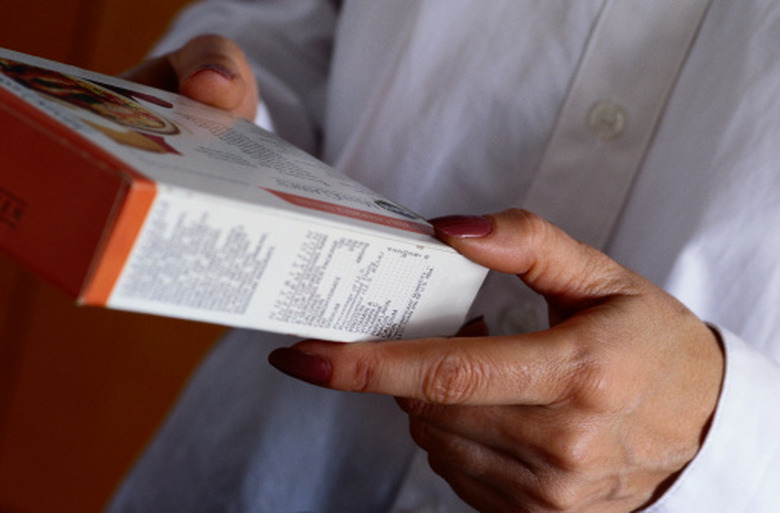How To Find Volume & Surface Area Of A Soup Can & Cereal Box
Finding container volume and surface area can help to uncover great savings at the store. For instance, assuming you're buying non-perishables, you want lots of volume for the same money. Cereal boxes and soup cans closely resemle simple geometric shapes. This is fortunate, since determining volume and surface area of amorphous objects can be tricky. Units are important in these calculations. Volume calculations should have cubic units such as centimeters cubed (cm^3). Surface areas should have square units, such as centimeters squared (cm^2).
Cereal Box
Step 1
Measure the height (h), width (w) and depth (d) of the cereal box. In this example, centimeters (cm) are used. Inches work just as well if calculations are consistent.
Step 2
Calculate external cereal box surface area (S) using the equation S = (2_d_h) + (2_w_h) + (2_d_w), which, when simplified, is S = 2(d_h + w_h + d_w). Cereal box volume (V) has formula V = d_hw. If w = 30 cm, h = 45cm and d = 7 cm, then surface area is S = 2[(7_45) + (30_45) + (7_30)] = 2_1875 = 3750 square centimeters (cm^2).
Step 3
Compute cereal box volume. In this example, V = d_h_w = 7_45_30 = 315*30 = 9450 cubic centimeters (cm^3).
Soup Can
Step 1
Measure soup can circumference (distance around) using a sufficiently long string, pen or marker and a ruler. Start with one end of the string and go around the soup can, keeping the string as close to perfectly horizontal as possible. Mark where the string encircles the soup can once. Unwind the string and measure the distance between the starting end and the mark. This length is the circumference.
Step 2
Calculate radius. The formula relating circular radius (r) and circumference (C) is C = 2_pi_r. Rearrange the equation to solve for r: r = C/(2_pi). If circumference is 41 cm, then radius is r = 41/(2_pi) = 6.53 cm.
Step 3
Find soup can height using a ruler or tape measure. Make sure the height measurement is in the same units (cm) as radius. For example, height (h) is 14.3 cm.
Step 4
Determine volume (V) and surface area (S). Soup can volume is determined through the formula V = 2_pih(r^2). Height h = 14.3 cm, r = 6.53 cm. Volume is V = 2_pi14.3(6.53^2) = 3831.26 cubic centimeters (cm^3). Surface area has the formula S = 2[pi_(r^2)] + 2_pi_hr. Substitute h and r-values to get S = 2[pi(6.53^2)] + 2_pi_14.3_6.53 = 267.92 + 586.72 = 854.64 square centimeters (cm^2).
Step 5
Use an accurate scale and liquid of known density to find internal soup can volume. Weigh an empty dry soup can. Add the liquid until it nearly–but not quite–overflows, and re-weigh the filled soup can. Divide added weight by liquid density. For instance If the liquid is water–density of one–a soup can that takes 3831 grams of water before overflowing has 3831/1 = 3831 mL (1 mL = 1 cm^3). If the liquid had density of 1.25 g/mL, then it would take 4788.75 grams of liquid to fill the same container since 4788.75 / 1.25 = 3831 mL = 3831 cm^3.
Things Needed
- Marked ruler (in "centimeters" if you'd like to follow the example)
- String or paper strip sufficiently long to wrap around a soup can
- Marker or pen visible on the string
- Calculator
Warning
Make sure the liquid in the soup can volume-determination method is not corrosive or dangerous.
Cite This Article
MLA
Aberdeen, Stan. "How To Find Volume & Surface Area Of A Soup Can & Cereal Box" sciencing.com, https://www.sciencing.com/volume-soup-can-cereal-box-7476433/. 24 April 2017.
APA
Aberdeen, Stan. (2017, April 24). How To Find Volume & Surface Area Of A Soup Can & Cereal Box. sciencing.com. Retrieved from https://www.sciencing.com/volume-soup-can-cereal-box-7476433/
Chicago
Aberdeen, Stan. How To Find Volume & Surface Area Of A Soup Can & Cereal Box last modified March 24, 2022. https://www.sciencing.com/volume-soup-can-cereal-box-7476433/
